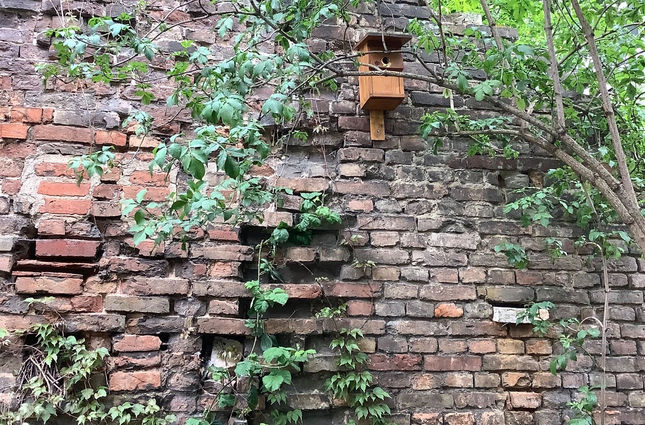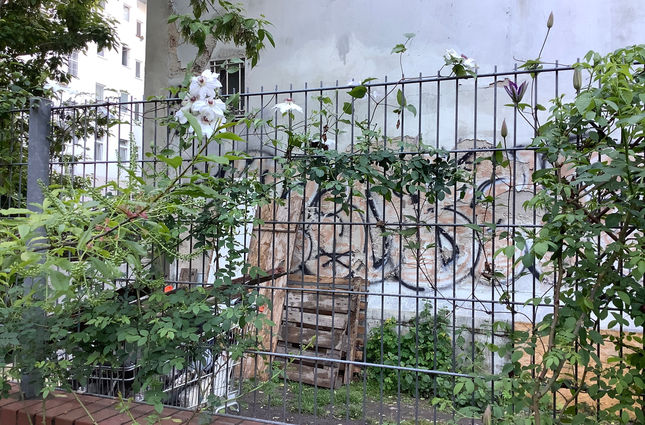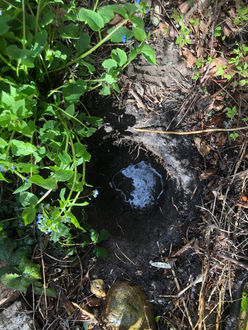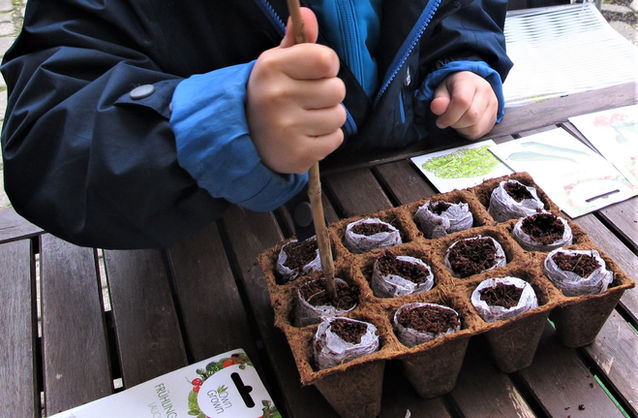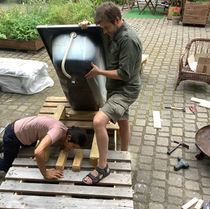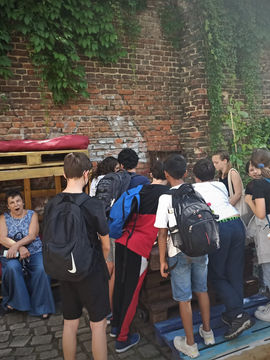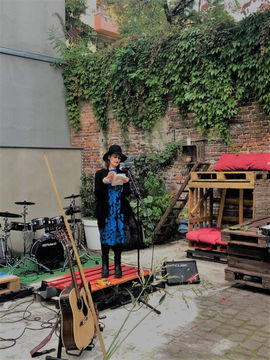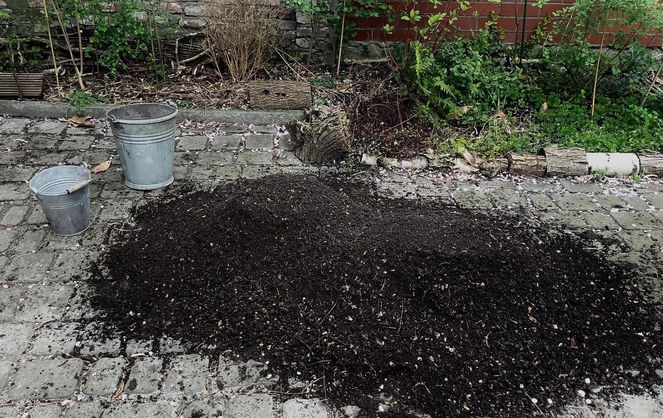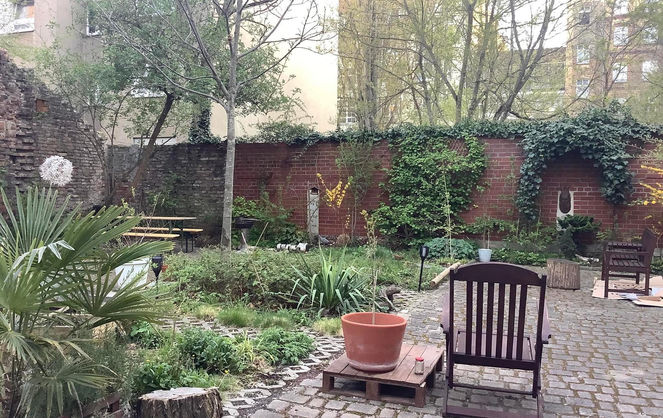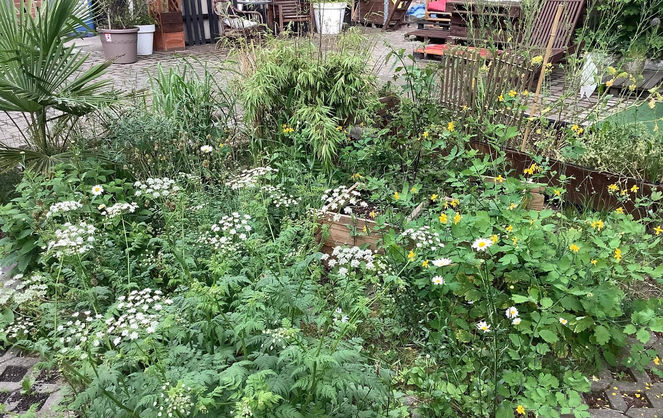top of page

2020-2022
Sustainability: Community and Ecosystem
By early spring 2020, the vitality of a whole new system of fauna and flora had become visible, from herbs to flowers, from shrubs to trees, from flower beds to central meadows, and from pots to walls and the railing to the adjoining courtyard still under construction. The healthy growth of the species led us to believe that a balance had been achieved. We had specialist birds and insects, the various areas for human cohabitation had also been gradually furnished and laid out taking into account the suitable sun exposure for the variety of activities of the residents.
When Covid-19 first sent us all into prolonged quarantines in the buildings, the garden constituted a true oasis of refuge for neighbors never seen before, also prolonging the time of permanence of those who already frequented it, such as the workers in one of the offices, who began, notably, to receive clients in the common space where we continued alone to care for the soil, its animals and plants, as well as for the revitalization of a larger tiled area and the maintenance of the many structures and equipment that we acquired, collected, transformed or built. Once confined, we also began a work of research and artistic collaborations incident within the space itself.
It was at this time that we started a residence in the courtyard, which would last for about four months and which would trigger the foundation of this collective, initially inviting artists and an anthropologist to reflect with us from a distance on this history of occupation and creation of Nature in a semi-public space, but soon also extending the invitation to participation to all neighbors: the usual ones, but also those we didn't know yet, frequenting the garden without any information about its origin and, naturally, without any responsibilities in its maintenance. All investments in the space were at the time still entirely of our responsibility, since in 2017 the new owner and current landlord of all the houses and offices had authorized us to keep the garden at our charge, cancelling the annual maintenance costs to all tenants. Understanding that the management of this new flow of human use in the context of a pandemic would now have to be formalized, not least because new conflicts concerning hygiene rules and consumption habits during quarantines were beginning to appear, we called a general meeting for all those interested in the garden. This meeting, attended by about eight people representing five houses, resulted in a list of rules for the use of the space adapted to the pandemic and the commitment to collaborate in the accommodation of the recycled waste (which had rapidly increased in production), in the care of the plants, in the order, cleaning and maintenance of furniture and other equipment. It was agreed to use the window recovered from the 2017 fire, where we had posted the first map of the garden, as a place accessible to all to share information and continue communicating; interest was expressed in participating in seasonal costs, project funding and gardening and permaculture training; we undertook to draw up an estimate of past and future budgets, as well as offering free training to develop the project collectively.
In 2020, in the presence of the owner, a municipal inspection to verify the safety of the structures also took place, in which compliance with legislation was ensured. At the same time, we also ensured the occupation of the enormous tiled area at the entrance to the courtyard, next to the new wall separating it from the rubbish area, where we had already installed raised beds, furniture and gardening equipment. We were working on new projects there, and the area was also a popular leisure and meeting area for residents, where the owner intended to install part of the new bicycle parking. Besides the four exhibitions of the cabaret resulting from the artist residency, which we presented there in the extraordinary context of the pandemic, attracting a large part of the users of the space, as well as local activists, colleagues and friends, and enabling a first public discussion about the Reichen-Hof project, the conditions for the sustained development of collective creative processes were also created in the months preceding them. A neighbor collaborated in the video made at the installation of the desert cactus section, another one photographed the first show, as well as the ones that followed in 2021. These neighbors, along with a third resident, also participated in the various introductory permaculture workshops and urban gardening actions we held then, with a view to their continued interest in the care of the garden over the following seasons: one of them would collaborate in funding the construction of a new compost bin, investing in her own vegetable bed and, over the course of a year, would also take responsibility for weed removal and some of the cleaning of the tiled area. All the others, those who also became interested in the plants and those who became engaged in discussing the socio-cultural aspect of the project, never actually committed themselves to regular tasks and costs. The participation in the development of occasional projects and events, however, gave evidence of some communal intentionality.
Despite the success of the occupation and the establishment of the ecosystem, it became obvious in 2021 that the management of the use of the space and the maintenance of the garden and equipment would not count on more support or effective collaborations. In the window reserved for communication in this regard, we continued to work on sharing information and registering the scheduling of tasks, projects and costs, as well as invitations to larger actions for the prosperity of the plants, such as the composting and fertilization workshops. These workshops brought few residents, and did not constitute a working group capable of deepening knowledge, but they attracted some interested participants through social networks, at a time when we had already extended the activity of the collective to pedagogy, starting now to organize leisure time workshops and language learning for children and young people with recourse to gardening techniques, dramatic expression, crafts and capoeira.
At the beginning of the summer, we developed a project, in partnership with two neighbors, to design a mobile communal tank. Built from a bathtub, pallets and seedbeds, it would function not only for human enjoyment, but also as a water reservoir, enlarging the surface of plants. In the workshops, we would use it to transmit basic ecological knowledge, such as the retention of water and the reuse of materials. This project inspired a performance block in collaboration with artists from the collective, local activists and the same neighbors, and was presented to the public in a day full of activities involving a reading, a small capoeira Angola circle and multi-generational games. Already at the end of the season, we presented the concert of a local band, during which we brought several citizenship discourses to the stage, from the conditions of production and artistic education in Portugal to climate activism in the world, and the struggle for the rights of indigenous women in Argentina. Before that, we had convened a second general meeting of neighbors, from which a scheduled distribution of tasks resulted (that, in the medium term, would not materialize). Our resident gardener would be absent already in the autumn, and also the following spring: it was made clear to all present that an effective and continuous collaboration would become imperative for the sustainability of the Reichen-Hof project. Three of the seven residents participating in this meeting would move out months later.

At the beginning of 2022, we divided the efforts of our two-person team between research in the interior of Portugal - having in view the building of a pedagogical farm where it is our intention to further develop projects of this collective, - and the maintenance of the created ecosystem in Berlin. Spring brought the unique collaboration of a guest gardener in composting, fertilizing and urgent cuttings, as well as an anonymous invasion of the raised beds, pots and soil in the form of eggshells and a tomato monoculture, which made the pedagogical work of sowing, watering and harvesting with children very difficult, killing some species and atrophying others. Meanwhile, the abrupt construction of a wall between the garden and the adjacent patio destroyed structures and killed plants, creating new conditions of sun exposure and air circulation, which will undoubtedly continue to inspire continued care. The first rescue actions, including a radical cut and the reconstruction of structures to support the recovery of the plants, once again took place in the absence of any interested parties.
The rotation of the tenants of most of the flats meant, finally, that more effort had to be put into providing information about the autonomous, but not collective, management of the space, attracting only one small family who, for the first time in the community's history, volunteered to share costs and immediately began to collaborate in the garden's daily tasks. Once gone, we now know that without a team fluent in some techniques and interested in the concept of the project, there will be no replacement of costs for everyone, by the owner, that will be able to take care of the maintenance of the equipment and the diversity of fauna and flora: its probable destiny will be to disappear, giving place or not to a traditional garden bereft of an island for insects and birds or a soil full of life, of which the freshness and beauty created are testimony. This summer, we wanted to extend an invitation to the permaculture and gardening community in Berlin, perhaps interested in the future rescue of some species and structures, as well as to those neighbors who might want to take responsibility for the agreement reached with the owner, for a wider public reflection. The oral transmission of knowledge combined with a systematic practice for the common good, assumed by the community itself, was and will be the perspective with which we will continue to approach the sustainable relationship between an ecosystem and human intervention.
In the fall, we signalled the last harvest with a performative ceremony on October 31, 2022. This event brought together, for the last time, artists, activists, friends, supporters, new collaborators and neighbors from different backgrounds, languages and generations. We shared a communal soup and discussed the past and future of the courtyard and of our project. In the spring of 2023, we donated and sold equipment and plants, officially ending our occupation. At the beginning of the summer, the landlord and the neighboring landlord intervened again on two walls of the courtyard: we didn't interfere in the works, nor did we rescue any plants.
In July, we left for Portugal for good, where we will start a new socio-cultural, artistic and ecological project from scratch in the Baixo Alentejo region.
Rita Ferreira e Luís Gabriel

All Videos
bottom of page


